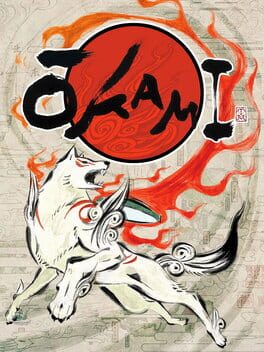
This was probably one of the things that infuriated me the most about Capcom. It wasn't enough that they destroyed one of my favorite RPG series (Breath of Fire), bastardized one of my favorite action series (Megaman), now they went and axed one of the finest production studios they had under them. Clover Studios scored a massive hit gameplay-wise, art-wise, and music-wise with their title, Okami. Interesting fun fact is that pronounced differently, the name can mean "Great God (ookami) or wolf (okami), which the main character is in this title.
To quote Yahtzee (though this was used for a different game), "If you find the Japanese offensive, then you'll find this game offensively Japanese." Okami is a very stylized version of Japanese mythology, taking unabashedly from its roots and shaping it into a beautiful, innovative title. It takes place in an undisclosed time period of Japanese history, weaving in myths and folklore to tell a new story about the sun goddess, Amaterasu and her journey in the shape of the white wolf, Shiranui to destroy the dark curses placed across the land of Nippon. Having lost the praise of the Nippon people as well as a multitude of her celestial powers as a result, Amaterasu battles the forces of the demon Orochi. Along the way, she rescues the Brush Gods, which grant her the ability to create various effects by literally painting them on the world. For example, Amaterasu herself is the Sun Goddess, and therefore discovers her own ability of Sunrise to change night into day (by drawing a circle in the sky). Another example is Gekigami, the God of Thunder, who's brush power allows Amaterasu to create lightning by drawing a lightning bolt with her Celestial Brush (interestingly enough, this is shaped like Shiranui's tail).
The characters are vivid and interesting, and the subplots of each area rarely interfere with the actual story, and if they do it usually grants a new God power to more than make up for it. The story posesses a few intriguing plot twists, as well as trainable skills and upgrades to your already potent brush abilities as you progress. The controls are very intuitive, and the three different types of weapons helps cater to different styles of play.
The three weapon types are all based on the Imperial Regalia of Japan. The reflectors (based on the Yata no Kagami) are balanced weapons with moderate attack speed, power, and knockback. Beads (based on the Yasakani no Magatama) are weaker powered weapons with incredible attack speed and multiple hits per swing. Glaives (based on the sword Kusanagi) are slow weapons with great power, and the ability to charge up attacks. You can equip a main weapon used with the X button as well as a subweapon that can be used with the square button, allowing a myriad of different combinations. Brush powers are intuitive enough, though some take some practice to get used to. Upgrades often allow you to perform an elemental move without a source of that element nearby to draw from, such as Moegami's Fireburst power that allows you to incinerate foes and obstacles. The combat system becomes interesting in that many enemies only have weaknesses to certain brush powers or abilities, and once you damage them you can perform a coup de'tat with that particular brush power to create a spectacular 'floral finish'. Each battle, which occurs in a pseudo real-time format by walking into moving demon scrolls on the field, is graded and grants money used to purchase items and upgrades.
By far one of the strongest points of this game is its art style. The entire game is made in pseudo sumi-e, japanese watercolor and ink style that was intended to further drive home the point that players have a great deal of interactivity with the world of Okami via the brush powers of the same sumi-e style. While the original 3D photo-realistic version was nearly incompatible with the PS2's processing power, it is this reviewer's belief that the game works better in this distinctively japanese stylization. The game is truly a work of art.
The music for the game is derivative of classical Japanese, with a few modern twists for the more dramatic songs. One such is "Reset" by Ayaka Hirahara, and has become one of my most favorite video game songs ever. The music generally and genuinely fits the mood for wherever the game happens to be, and rarely gets annoying or monotonous to listen to (if you like classical Japanese music, at least).
These facts are all what made it heartrending when Capcom closed Clover Studios a year after Okami's release, subsequently leaving no chance of a possible sequel. I honestly don't understand why they would do such a thing, the game was a gorgeous, innovative, and genuinely fun product. I just wish they'd stop fucking things up. Words fail to describe the spectacle of this game, and it even comes with a New Game+ mode to enjoy with costumes for Amaterasu, including the photo-realistic model they were originally going to use and a bead rosary that makes you invincible.
Why, Capcom? Why did you destroy one of the greatest studios you've had?

